Eat Seasonally in February: Blood Oranges
Posted by Julie on Feb 6th 2017
The weather may still be cold and gray, but our seasonal pick for February is bright and cheery. Blood oranges are sweet and delicious whether you juice them, cook with them, or eat them plain. Plus, their gorgeous color is perfect for Valentine's Day.
Keep reading to learn how blood oranges differ from navel oranges, along with scrumptious ways to enjoy this seasonal fruit.
Blood Oranges vs. Navel Oranges
Navel oranges are the bright orange fruit typically found in lunch boxes and passed around after kids' soccer games. Blood oranges differ from navel oranges in several ways. For one, they have a thinner peel and a redder hue, both inside and out. In fact, blood oranges get their name from the color of their flesh.

Blood oranges are also higher in Vitamin C than navel oranges. They contain anthocyanins, which give them their distinctive color. Anthocyanins may also be good for our health -- studies have shown them to be anti-inflammatory, anti-carcinogenic, and beneficial to the cardiovascular system.
Ways to Enjoy Blood Oranges
We're all for peeling and eating these delicious fruits all by themselves, but they're also great in various recipes.
While we don't normally start with dessert, we are today. Check out this post from The Kitchn with all the details for making citrus curd. We love it because the same formula works no matter what type of citrus fruit you use, including blood oranges.
Once your blood orange curd has cooled, there are dozens of ways you can use it. Use it as cake filling between layers, in place of frosting. Whip it with softened cream cheese and spoon it into tart shells. Spread it on pancakes or crepes. Stir it into yogurt or oatmeal. Or just eat it straight from the bowl -- we won't judge.

Blood oranges also go well in salads and salad dressings. The juice makes dressing sweet, so you don't have to add granulated sugar. This Blood Orange Avocado Quinoa and Kale Salad from Sally's Baking Addiction looks fantastic -- nutritious, simple and full of flavor. We love her suggestion to crumble bacon over the top. Plus this is one of those recipes that's great for leftovers: the flavors meld and intensify in the refrigerator overnight.
Finally, we also want to try this recipe from Whitney Bond for Blood Orange Baked Salmon and Carrots. It looks so light, bright and spring-like, especially topped with chopped cilantro. Whisk the blood orange juice with chipotle powder and honey to make a glaze for the salmon. Or double the glaze ingredients and pour half of it over the fish and carrots before baking. Then reduce the rest of it on the stovetop to make a thicker sauce for serving.

